Dark Energy Spectroscopic Instrument
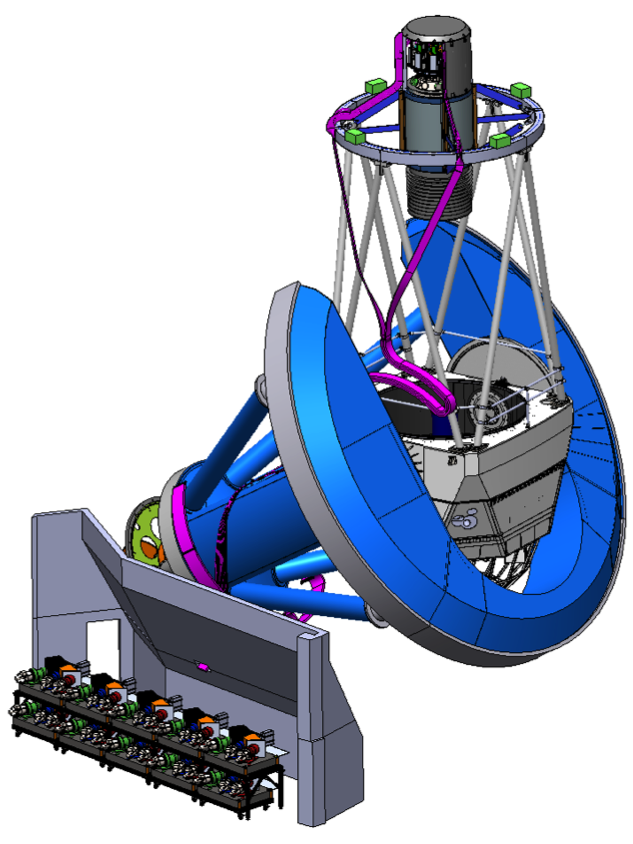
|
The discovery of cosmic acceleration in the late 1990s was one of the most startling scientific discoveries of the century, and the origin of cosmic acceleration remains unknown. The two main possibilities are the existence of some mysterious dark energy that counteracts gravity and a modification to Einstein's General Theory of Relativity that causes gravity to become a repulsive force on very large scales. Progressively more ambitious surveys have aimed to use standard candles and standard rulers to measure the rate of cosmic expansion over the history of the universe in order to determine if the acceleration is consistent with a cosmological constant, modified gravity, or some more exotic solution.
I am significantly involved in an ambitious new survey called the Dark Energy Spectroscopic Instrument (DESI), which will obtain substantially better measurements of the cosmic expansion rate than previous surveys. DESI aims to obtain spectra for more than 30 million galaxies and quasars over 14,000 square degrees of the northern sky. DESI will be able to observe so many targets thanks to a new, 8 square degree prime focus corrector, a 5000-fiber positioner system, and ten bench-mounted spectrographs. The figure to the left shows a model of DESI installed at the 4-m Mayall telescope at Kitt Peak National Observatory. The 5-yr DESI survey is scheduled to begin in 2019.
|
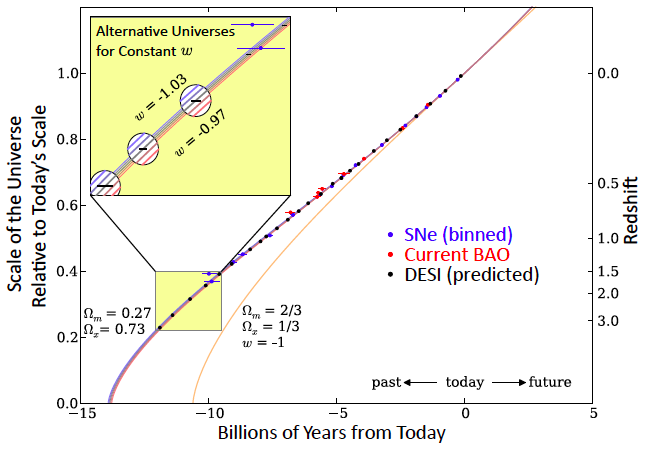
|
DESI will measure the rate and evolution of cosmic expansion with Baryon Acoustic Oscillations (BAO), as well as measure the growth of structure with redshift space distortions. The BAO scale corresponds to a fixed physical length scale or ''standard ruler'' that was imprinted on the distribution of baryons in the early universe. DESI will measure this scale over most of the age of the universe (up to about redshift three), and will consequently provide the best measurement of the dark energy contribution. The figure to the left shows the cosmic expansion history as a function of time for different models of dark energy. The inset shows five models with constant w from -0.97 to -1.03, and illustrates how DESI will achieve the precision necessary to discriminate between these values of w.
|
Here are several papers with more information:
- Overview of the Dark Energy Spectroscopic Instrument
- The DESI Experiment Part I: Science,Targeting, and Survey Design
- The DESI Experiment Part II: Instrument Design
Quasar Selection and BAO with the Lyman Alpha Forest
|
While the dark energy component only appears to dominate cosmic acceleration at redshifts less than one, measurements at higher redshifts are important to search for and measure evolution in its contribution early in the history of the universe. At the earliest times, DESI will use measurements of rare but luminous quasars to derive BAO measurements from the absorption of neutral Hydrogen along the line of sight to each quasar. Because there are many absorption features in each quasar spectrum, and absorption features correspond to matter overdensities, each quasar spectrum provides more than an order of magnitude more information than redshifts of lower-redshift galaxies and quasars.
The surface density of high-redshift quasars is very low compared to lower-redshift galaxies and quasars, and they are difficult to select, so efficient and complete quasar selection is very important for DESI to meet its survey goals. My current research interests include algorithms to improve quasar selection and extract the most information from these data.
The figure to the left shows an illustration of quasar selection with multi-color data from the Dark Energy Survey. The large, red points are spectroscopically confirmed quasars, and the small, black dots are other point sources. The dashed lines mark a quasar selection region with high completeness and efficiency.
|
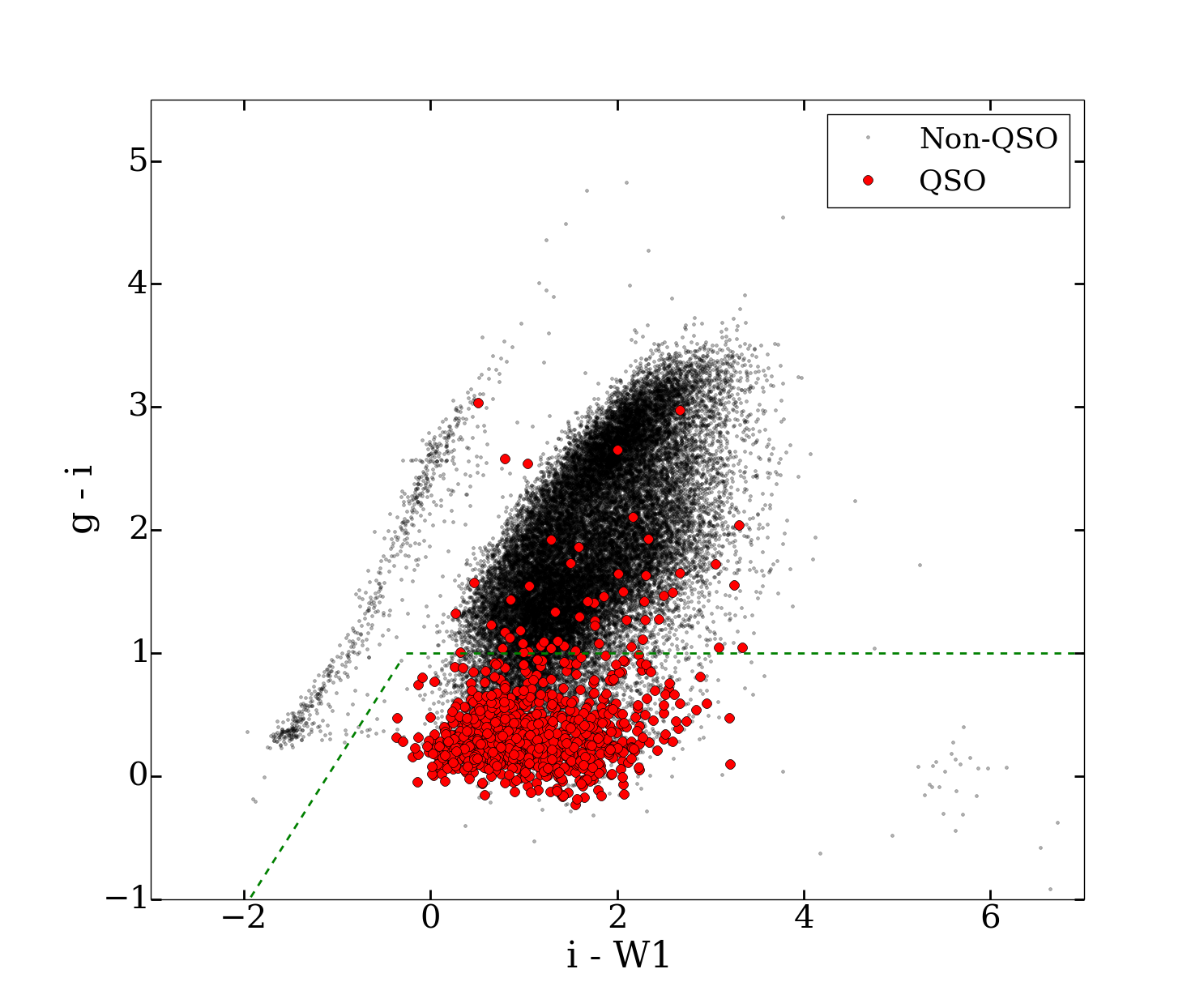
|
Reverberation Mapping and Supermassive Black Holes
My other main research project aims to measure the masses of several hundred supermassive black holes (SMBHs) at high redshifts. This is interesting because most SMBH growth occured at redshifts of 1 to 3, approximately coincident with the peak of QSO activity, and high-quality mass measurements are needed in order to accurately determine how SMBHs grew over cosmic time. Some of the many SMBH demographics questions that I hope to address include the evolution of the SMBH mass function, how the Eddington ratio distribution depends on SMBH mass and other parameters, and how the growth rate correlates with host galaxy properties such as stellar mass and star formation rate.
The OzDES Reverberation Mapping Project began in 2012 and combines high-quality photometric light curves from the Dark Energy Survey and emission-line flux measurements from OzDES. We are presently obtaining spectra for nearly 800 quasars. The figure below (left) shows the redshift distribution of our targets, combined with the predicted lag (from King et al. 2015) and results from other recent work. The right panel shows the expected recovery fraction as a function of redshift based on simulations by Anthea King that included took into account the data quality, the observing cadence, and the impact of weather.
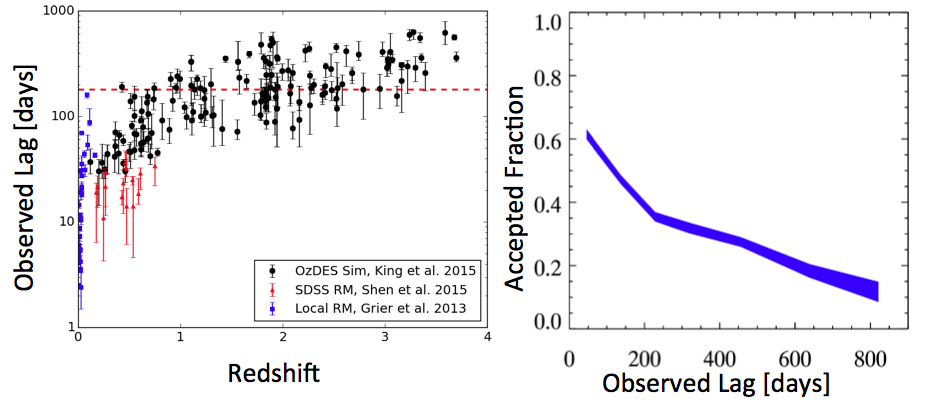
Another aspect of our photometric data from DES is that we can use these data to estimate the sizes of accretion disks in quasars. Quasar variability is driven by changes in
the accretion rate, and the most direct consequence of those changes is variation in the X-ray luminosity at the center of the disk. These high energy photons then illuminate the rest of the disk, which increases in temperature and emits radiation in response to this heating. As the disk has a temperature gradient, and lower temperatures tend to dominate the emission at longer wavelengths, the relatively time lag between different wavelengths encodes information about the size of the disk. The figure below shows three light curves for a quasar observed by DES, as well as the lag between the two longer-wavelength filters relative to the shortest wavelength.
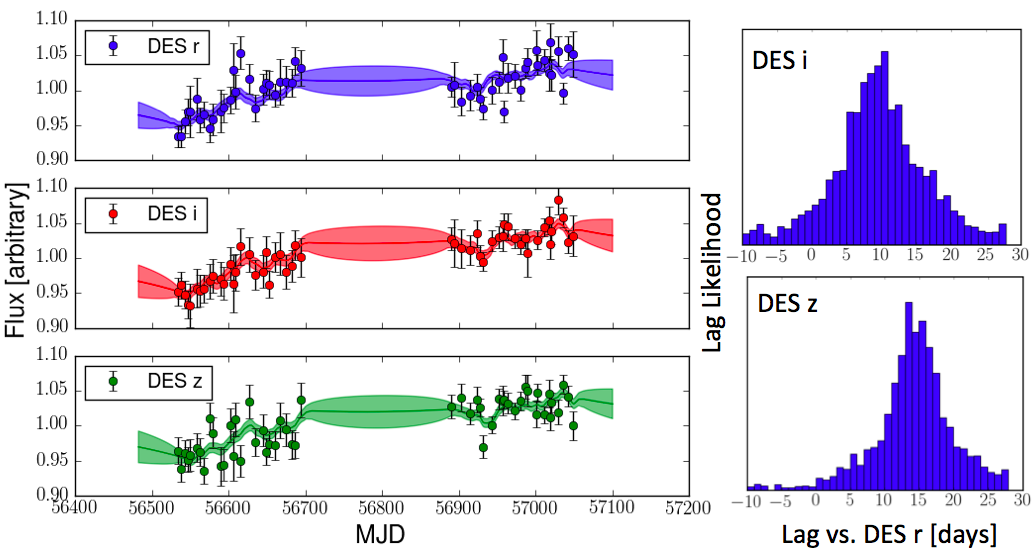
For more information about the DES-OzDES Reverberation Mapping Project, please see the following papers:
- Yu, Zhefu, Martini, Paul, Davis, Tamara M. et al. 2018, Quasar Accretion Disk Sizes from Continuum Reverberation Mapping in the DES Standard Star Fields, ApJ, submitted
- Mudd, Dale M., Martini, Paul, Yu, Zhefu. et al. 2018, Quasar Accretion Disk Sizes from Continuum Reverberation Mapping from the Dark Energy Survey, ApJ, 862, 123
- King, Anthea L., Martini, Paul, Davis, Tamara M. et al. 2015, Simulations of the OzDES AGN reverberation mapping project MNRAS, 453, 1701.
|






